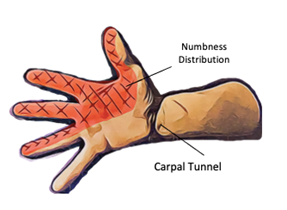
Focus on Carpal Tunnel Syndrome
Posted on 28 October, 2021 / Written by admin
What is Carpal Tunnel Syndrome?
The carpal tunnel is a small space base of the hand. This tunnel is covered by a thick ligament and creates a small tunnel where various nerves, arteries and tendons pass through from the forearm into the hand. If anything causes this space to be reduced, these structures can become compressed and damaged, particularly the median nerve. This common condition is referred to as Carpal Tunnel Syndrome (CTS).
What are the symptoms?
The hallmark symptoms of carpal tunnel syndrome are pain, numbness and weakness in the hand, usually following a typical pattern over the thumb, index and middle finger. There can also be a reduction in grip strength and wasting of the thumb muscles. Symptoms are usually worse on waking or with repetitive hand movements. Patients might also report difficulty holding items, writing or doing up their buttons.
How does it happen?
Carpal tunnel syndrome can be caused by anything that reduces the space in the carpal tunnel, including arthritis, the growth of a cyst or compression from everyday activities. The median nerve is particularly vulnerable to compression and is of the most concern as prolonged compression can cause nerve damage and permanent weakness of the hands.
How is it treated?
There are a few different treatment options for CTS. Non-surgical treatment is often recommended first, which includes physiotherapy, wearing a splint, cortisone or plasma rich platelet injections to promote nerve healing. The effectiveness of physiotherapy will depend on the cause of your carpal tunnel. If the space of the tunnel has been reduced permanently, such as with arthritis, then surgery is likely to be the most effective treatment. Carpal tunnel surgery is an operation to widen and release the carpal tunnel allowing decompression. This is a common surgery but is not without its risks or complications and requires a period of time off work for recovery.
For non-surgical cases, altered biomechanics of the arm, the mobility of the median nerve and muscle tightness may all be contributing to symptoms. In this case, physiotherapy can be highly effective, along with a period of rest, splinting and a change in daily habits.
None of the information in this newsletter is a replacement for proper medical advice. Always see a medical professional for advice on your injury.


